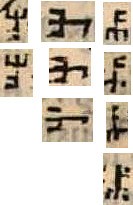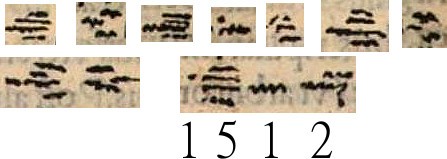The Devil’s Handwriting is one of my favourite little cipher mysteries, for the simple reason that it manages to combine age (it first appeared in print in 1532), brevity (it’s just under seven lines) and devilish visual wit (pitchforks and bats). I have no idea who its alleged author / owner Ludovico of Spoleto was, but I have to say I’m liking him already.
All the same, one question you always have to ask with old ciphertexts is whether they are actually simpler than they first appear: really, are we making too much of a fuss about it? Having toyed with The Devil’s Handwriting for a while here at Cipher Mysteries Towers, it now seems to me that most of the character variation we see in it was probably down to a scratchy old quill (as well as someone making a copy of an unclear original) rather than a hideously Byzantine homophonic cipher. Really, I think it’ll turn out to be nothing more than a monoalphabetic simple substitution cipher, albeit one that has been dragged backwards through a couple of hedges on its lengthy route through time to us.
The difficult bit, of course, is working out what its original alphabet was and what is, for want of a better phrase, the entropic decay that has happened to it ever since. However, if we start from my nicely sharpened version of the ciphertext and look a bit more closely at the shapes used in its devil-themed alphabet, I think we can see that some of the original patterns and structures are still visible.
Firstly, the ‘flourished pitchfork’ shape seems so consistent across all of its eight instances that I for one find it hard to imagine that it was not actually a single character in the original ciphertext.
Secondly, pretty much wherever the repeated pitchfork character has an extra leg or two going off to one side from the stem, the leg(s) always seems to go clockwise.
Thirdly, there’s just something about the ‘bats’ that reminds me of improvised peasant ciphers. I can’t help thinking that these are probably just enciphering Arabic digits, with (say) three enciphered as three bats. Of course, I also believe that what we’re looking at is a book copy of a version that was itself at least a copy, so that these are far less clear than we would like (and the degradation to these ‘bat-numbers’ may well prove impossible to reverse, however much we would like to). Despite all that, I’m reasonably confident that digits are indeed what we are looking at here, and that the plaintext may well have ended with a 4-digit year, e.g. something, for the sake or argument, not entirely unlike “1512”.
Fourthly, because there only a few other characters in the cipher alphabet (e.g. the ‘::’ four-dot character, etc), I think it likely that the original monoalphabetic substitution alphabet used (say) 21 letter instances, less four or five extra characters, yielding sixteen pitchfork characters shared between four rotations, i.e. four individual shapes per pitchfork / pigpen rotation. Maybe they originally looked something like this:-
Finally, I think there seems little reason not to believe that the plaintext is in either Italian (strictly speaking Tuscan or perhaps Venetian) or Latin, with Tuscan being the one on the shortest odds at the bookies.
Is this such a scary cipher any more? Hopefully a little less than before! 😉




Very interesting!
This does seem interesting. Do you know if anyone (not necessarily of this site) has figured it out yet?
I was thinking about seeing if I could crack it, but for someone new to all this, I should probably choose something in English…
Hi
I was doing some general research on the Devil’s Alphabet and came across this posting which amongst the limited info on the internet relating to this subject is by far the most interesting.
A couple of things to add to your thoughts:- You mention that you are concerned that the differences between the pitchfork tailed character may be due to a scratchy quill. This may be true in the original writing of these characters, but I believe that the printed image in the book is done from a woodcut rather than manuscripted into the book as the eastern alphabets in the book are. I have a copy of the book and the characters are identical in minute detail to those posted on your link including the faint markings surrounding the characters. It is always possible that the image you have was originally take from my book of course prior to my ownership! I will check that out next time I have the opportunity to see another copy.
A further minor point of interest in my book is that I can see two very small manuscripted corrections to characters 2 and 10 using brown ink. The ink colour is the same colour as used in a number of margin notes and other corrections in the book and I am reasonably sure it is 16th C. The interesting thing here for me is that someone at some time felt the need to make these minor corrections, which if the characters were apocryphal or simply made up for fun, the author would not I think have bothered to make such corrections. This leads me to think that there is something there and worth further perusal but sadly beyond my area of study. I wish you success with any further efforts on this one.
Tony: thanks very much for dropping by! I’ve long been fascinated by the Devil’s Handwriting / Alphabet, because it seems to be a puzzle that really ought to be crackable, if only we can find a way of grasping its letter structure better. Overall, my reading of the print is indeed that it is a woodcut copied from an original that was ‘variably inked’, let’s say. The person who created the woodcut did his/her best to reproduce that variably inked original text, but I suspect that this process perhaps may have served to accent the variation, making a modern decryption that much harder.
But anyway – from what you’ve said, I suspect that your copy may be quite extraordinary: I’ve seen scans of a few different copies, and yours is the only one I’ve heard of with corrections to this page. To my mind, this suggests one of only a few intriguing scenarios:-
(1) correction of the transcription by someone who had seen the original ciphertext – perhaps the author himself, though because this correction was not applied to other copies, this perhaps seems unlikely;
(2) correction of the ciphertext by the person who created it or directly knew its secrets (but this too seems unlikely);
(3) correction of the ciphertext by someone who had cracked it back in the 16th century.
Is there any chance you could scan or take a digital photo of your copy of this page and send it through? I’d really like to update my page on it with a better quality scan.
Finally: I’d also be interested to know if the copy has any other marginalia in the same hand that might suggest who that marginalia-adding person was. For example, triangles in the margin are usually a bit of a giveaway. 😉
This looks similar to Theban Alphabet or Johannes Trithemius Alphabetical system. Johannes died before 1532, but lived until 1516. He would’ve been well-versed in this form of script, especially when one considers he was equally skilled at steganography (Steganographia)….hiding knowledge in plain site so only the trained eye can detect it.